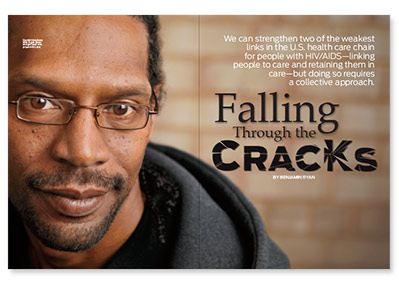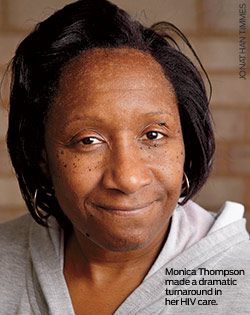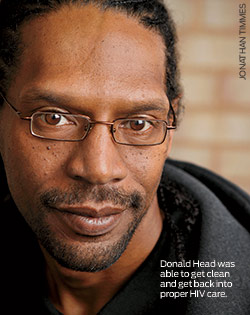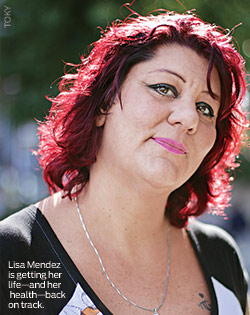
Monica Thompson was 23 years old in 1989 when she found out she was HIV positive and six years into an addiction to alcohol and crack cocaine that would escalate across the next decade of her life.
During those troubled times, caring for herself—not to mention her children, who were either put in “the system” or sent to live with her grandfather—took a backseat to her desire for instant gratification.
Her doctor put her on AZT (Retrovir) and ddI (Videx), the only available anti-HIV drugs at the time. But she says, “I would become my own doctor and decide, ‘I don’t want to take my medication.’ I was in denial about being positive, because my addiction was full force. I didn’t keep certain [medical] appointments, especially if I was out getting high.”
Now, at 47, the Washington, DC, resident has made a dramatic turnaround. She’s been seeing the same physician for almost 10 years and has been on a stable antiretroviral cocktail for seven, boasting a robust CD4 count and a long-standing undetectable viral load. Completely sober since 2007, she’s also gotten her bipolar disorder under better control, thanks to a good relationship with a psychiatrist. She has since brought all three of her children back into her life.
She is also engaged to a man, Donald Head, 46, whose own departure from proper HIV care mirrors her history. The shock of becoming infected with HIV after he got out of prison in 2009 contributed to his decline back into an addiction to cocaine and alcohol, which kept him from adhering to his medications or seeing the doctor. Ultimately he was able to get clean and get back into proper HIV care.
Outside of their love for each other, a major common thread this couple shares is the debt of gratitude they owe to a pair of DC–area social service agencies devoted to ensuring people like them don’t fall through the cracks and fall out of the health care system when life’s hardships get in the way.
Thompson became a client of Women’s Collective, which helps low-income women and children with HIV in DC.
“The case manager will follow-up with me to make sure I go to the doctor,” she says. “If I have an issue where I’ve been sick or whatever, they call to check on me and make sure if there’s anything that I need. They assist me if I need transportation.”
Thompson’s case manager also helped her switch from a psychiatrist who made her uncomfortable to one who was more likely to keep her coming back, ensuring her the mental stability she needs to stay off drugs.
Thompson met Head working at the Community Education Group (CEG), which supports the African-American HIV community in DC. He was fortunate enough to land a job there after getting out of jail—CEG has a skills-training program for those re-entering society that can lead to employment—and he was lucky to have a supportive boss who, instead of firing him after he failed a drug test, guided him into a Narcotics Anonymous program that has helped keep him sober, as well as to an HIV support group.
“I think my success is only as strong as my support system,” said Head, “and CEG is my backbone. If I wouldn’t have had the job, I probably would’ve went straight back to the street: doing my usual, selling drugs, the same thing I got locked up for.”
A central goal of the National HIV/AIDS Strategy is to ensure that all Americans with HIV are engaged in proper care. Pharmaceutical companies have spent vast sums of money over the decades to make the simplest, most tolerable antiretroviral drugs, with the ultimate goal of improving adherence and thus the likelihood of achieving an undetectable viral load. With recent research showing that fully suppressing the virus can significantly reduce infectiousness, and that early treatment may lead to improved health outcomes, the drive to get people with HIV on treatment as early as possible is on a steady, upward tilt.
Yet only an estimated 16 to 36 percent of Americans with HIV have a suppressed viral load. This figure is the last calculation in a series of statistical wake-up calls that have shaken the HIV community since Edward Gardner, MD, an infectious disease specialist at Denver Public Health, published his paper in 2010 outlining a new catchphrase: the “treatment cascade.”
According to Gardner’s most recent numbers, of the estimated 1.2 million people living with HIV in the United States, only about 80 percent know they have the virus, between 60 and 68 percent are linked into HIV care, and between 30 and 41 percent are retained in HIV care—figures that cascade down to those dismal statistics showing that only 16 to 36 percent have an undetectable viral load.
It’s important to note that the upper range of Gardner’s estimates are higher than current figures from the Centers for Disease Control and Prevention (CDC). However, Gardner’s estimates consider potential statistical errors that are driven in part by failing to account for people who have switched health care providers but have not fallen out of care.
“When you look at CDC’s treatment cascade, probably more is known about the left side and the right side of that cascade than the middle,” says David R. Holtgrave, PhD, a professor at the Johns Hopkins Bloomberg School of Public Health, who studies linkage and retention interventions. In other words, we know far too little about those crucial middle bars where people like Thompson and Head are so likely to get lost.
Take Lisa Mendez, a 44-year-old Los Angeles resident who tested positive at a clinic in 2008 that never gave her a referral to an HIV specialist. She had spent six months suffering from severe flu-like symptoms that left her unable to hold down her job as a labor compliance officer. She was rendered homeless and put her son in foster care. Soon after her diagnosis, she attempted suicide. Only after three and half years passed did she finally find an HIV specialist.
“If I was diagnosing people,” Mendez says, “I would shuttle them somewhere where they would get the social support and the medical knowledge to get information so that they know what they’re dealing with. You need the social support in order to care enough to take care of yourself and your HIV.”
It just so happens that the shuttles Mendez imagines do exist. When outreach workers at DC’s Community Education Group get a positive result in one of their mobile testing units, they send a “linkage team” in unmarked vehicles to offer a ride to the doctor right then and there. Such tactics are working—and getting noticed. Last year, during the XIX International AIDS Conference, held in DC, U.S. Secretary of Health and Human Services Kathleen Sebelius singled out CEG for achieving a 95 percent linkage rate.
Ingrid Floyd, executive director of New York–based Iris House, which provides comprehensive support services to women and families affected by HIV, says the system of care “really works when the client feels accountable to the case manager. We treat our clients as family. There is a genuine care and concern about seeing improvements in health for everybody.” Iris House has a 98 percent linkage into care rate.
These agencies serve as an adjunct to area clinics or hospitals that have neither the wherewithal to conduct outreach into specific hard-hit communities, nor the funding to provide non-medical services like case management.
DC’s increasingly symbiotic system of engaging people with HIV into care appeared broken in 2007 when Shannon L. Hader, MD, MPH, became director of the HIV/AIDS, Hepatitis, STD and TB Division of the District of Columbia Department of Health. The district had a 3 percent HIV prevalence rate, and over 6 percent of black males had HIV. With just 48 percent of the HIV population in care and 24 percent on medications, only 12 percent were virally suppressed.
“We were still having a high rate of AIDS-related mortality, which is ridiculous in the era we’re in,” says Hader, who is now vice president and director of the Center for Health Systems and Solutions at the Futures Group, a global health consulting firm.
Beginning in 2009, Hader borrowed a highly successful model from DC–based Whitman-Walker Clinic (now known as Whitman-Walker Health) called the “Red Carpet Program.” HIV testing sites were encouraged to direct newly identified people with HIV to care providers who agreed to schedule a doctor’s appointment within 48 hours. She also worked to improve connections between outreach groups and health clinics to ensure more effective cooperation and communication between all the city’s players in the HIV care system.
Each summer Hader sponsored a “recapture blitz” in which health care providers went all out trying to reel in lost patients. While the average patient required numerous contacts before returning to care, they typically came back because they felt a social obligation to the person on the other end of the phone.
“In many cases, they had dropped out of care because someone had been rude to them the last time they came in,” Hader says. “The longer people had been out of care, the less likely they were to remember why they stopped going and they were actually easier to get through the door.”
Thanks to such efforts, the proportion of people with HIV entering care within three months of diagnosis in DC increased by 31 percent between 2006 and 2010. In 2010, 90 percent of new cases entered into care within a year and 76 percent within three months.
As the nation gears up for major elements of the Affordable Care Act (ACA) to go into effect in 2014, AIDS advocates are gunning for the new system to improve linkage and retention rates. Most critically, the ACA will provide coverage to much of the estimated 25 percent of people with HIV who lack insurance, either through the new health exchanges or through expanded Medicaid rolls. (At press time, nine states were not participating and six more were leaning toward opting out of Medicaid expansion.)
Massachusetts expanded Medicaid coverage for people with HIV in 2001 and passed universal health care in 2006. As such, it provides a glimpse at the possible future for people with HIV nationwide once insurance coverage is expanded. About 98 percent of Massachusetts’s HIV-positive residents are in medical care, 90 percent are on antiretrovirals and 70 percent are virally suppressed.
A key to the commonwealth’s success is the fact that it has creatively redirected Ryan White CARE Act federal dollars to more effectively fund the type of supportive services that help keep people with HIV engaged in care, but which aren’t covered by Medicaid or private insurance. This includes the case managers and care coordinators who help patients connect all the complicated dots of their treatment, as well as who help meet their psychosocial needs.
“We want to preserve the best of Ryan White,” says Nancy Mahon, executive director of the MAC AIDS Fund and chair of the Presidential Advisory Council on HIV/AIDS, of the efforts to protect the program as it comes up for reauthorization this year. “At the same time, [we want to] understand how the ACA interacts with those wraparound services.”
Those fighting for sustained Ryan White funding have data on their side. A recent sample of eight health sites funded by Ryan White Part C dollars found that 91 percent of patients were retained in care and 73 percent were virally suppressed.
“Happily, we have a [health] secretary who is very progressive in terms of HIV,” Mahon says of Kathleen Sebelius.
On December 1, 2012, which is World AIDS Day, Sebelius announced the federal government will include HIV/AIDS among the conditions that qualify for enhanced Medicaid reimbursement for what is known as a Health Home model— a system of integrated care many HIV clinics nationwide are already using to great success. In response, the HIV Health Access Working Group, a national task force of AIDS service organizations, sent an open letter urging the federal government to ensure the Health Home models will leverage Ryan White funding to maximize their effectiveness.
According to the treatment cascade researcher Edward Gardner, we could use a good deal more guidance on how to approach the linkage and retention problem. “There are a lot of people working on this, and it’s become a big deal, which is wonderful, because it’s important. But we don’t have much evidence base.”
Gardner points to the only controlled clinical trial of an intervention designed to improve linkage, known as ARTAS and published in the mid-2000s, as a first start that has inspired many service providers around the country. But he laments that it’s showing its age as the field awaits more rigorous research.
Michael Mugavero, MD, an associate professor at the University of Alabama at Birmingham School of Medicine, was one of the lead authors of a list of guidelines in 2012 that outlined how to improve linkage, retention and adherence—the result of a literature review.
“I think the service has outpaced the science,” Mugavero says, adding that medical providers, community based organizations and public health officials have grasped the linkage and retention problem for decades and have had to come up with practical solutions based on their own experience.
“We can’t wait,” he says of the need to institute changes to improve linkage and retention. “We need to act now. Even though we don’t have great evidence, we have some of the building blocks.”
Advocates tend to agree that many barriers to care are universal—including the lack of basic needs such as transportation, housing and food, as well as problems like substance use and stigma.
Often, other life challenges do take priority over their HIV, says A. Toni Young, founder and CEO of Community Education Group in DC. “For many of the people we work with, HIV is not necessarily primary, secondary, tertiary or ancillary,” she says.
However, experts differ on how much an intervention program needs to be tailored. “When I think about what’s an effective program to help link someone into care or to help retain them in care,” says Jeffrey Crowley, former director of the White House Office of National AIDS Policy and a lead author of the National HIV/AIDS Strategy, “I don’t know that those things are all that different. It is true that maybe a woman with children might have needs that a childless male doesn’t. But as far as the best things that are going to help them get into care or stay in care, they tend to be the same.”
Johns Hopkins’ David Holtgrave takes another view. “We have to think about, from client to client and region to region, that things may differ quite a lot,” he says, “and we have to come up with interventions focused on what that individual client or that individual geographic area are facing.”
Holtgrave has partnered with AIDS United on two separate studies that are looking at interventions tailored to a variety of sub-populations in different areas of the country. For example, his research group is seeking to better engage homeless people with HIV in San Francisco, and is also investigating how to use telemedicine in Montgomery, Alabama, where the density of HIV specialists is low and transportation is an issue.
Part of Holtgrave’s research has been an effort to create a cost analysis for engaging an individual with HIV into care. “People should not be turned off by price tags of $500 to $3,000 a client,” he says, referring to the general range he’s seen of the price to serve one person with HIV for six months with these interventions. “You really have to look at what’s the return on the investment.”
Holtgrave measures this return against the estimate that each new infection costs society about $400,000. Depending on the location, each program may only have to prevent about one new infection every six months to prove cost-effective.
Meanwhile, the MAC AIDS Fund is investing in new research. It gave the U.S. Health Resources and Services Administration a $250,000 grant to roll out a pilot program in Southern states that uses texting to help keep people with HIV in care. The Fund is also putting together a meeting with Holtgrave that will draw in experts from around the globe to seek their guidance on best practices. They also granted $4 million to AIDS United to improve retention among people with HIV who are living in poverty or who are traditionally underserved by medical care.
Another effort that’s gaining steam around the country is the use of local surveillance data to help providers determine which of their patients have been lost to care. Following CDC national surveillance reporting guidelines, DC gathers data whenever an HIV-positive resident gets a CD4 or viral load lab test. Careful to ensure that privacy isn’t breached, the district’s health department helps narrow local Ryan White clinics’ search for lost patients by informing the clinics if individual patients appear to be in care elsewhere. Similar uses of surveillance systems to alert providers that patients may have fallen out of care are also under way in Seattle and at the Louisiana Office of Public Health.
In November, Project Inform in San Francisco convened a think tank to discuss such measures with public health groups and community advocates from around the country. “Overall,” says Michael Mugavero, who attended the meeting, “there was a consensus that, if done properly, with attention to privacy and confidentiality, the idea of using expanded data sources and monitoring was a reasonable approach.”
Four years after learning her diagnosis, Lisa Mendez is starting antiretrovirals and has reunited with her son, thanks in no small part to the assistance she received from AIDS Project Los Angeles (APLA). The AIDS service organization has helped her with food, transportation and housing needs.
“If I wouldn’t have gotten linked in with [APLA] and gotten the social support and the groups and the information to help me live better with it and explain to my son about HIV, I honestly don’t know what I would’ve done,” she says. Calling herself “blessed,” she says, “life is good.”
Meanwhile, Monica Thompson and Donald Head are making their way to the altar, but are in no rush. Thompson, for one, is happy enough that she’s made such a break from her years as an addict. “I love who I am today,” she says. “Ten years ago, I didn’t love Monica.”
As for DC’s Sharon Hader, despite her successes, she reflects on the challenges ahead. “In this day and age in our national response we can still do better” to help people like Mendez, Thompson and Head.
“Finding out where there are gaps in health outcomes and how we look at our data and tweak our services to continue to improve is key,” Hader says. “The Affordable Care Act is a great next reform in health care finance, and it should increase a lot of flexibility and reduce some barriers. But finance reform in itself will not mediate some of these gaps that our programs try to address—people’s willingness and competence in engaging in the health care system, building the relationship between providers and clients, looking critically at where the missed opportunities are and focusing extra attention to bridge those opportunities.”
In other words, health care reform won’t solve our problems unless we find better ways to link people with HIV to care—and to keep them in care.






2 Comments
2 Comments